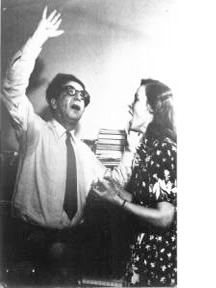
What is Voice Movement Therapy (VMT)?
 The human voice reflects both physical and psychic states and has the ability to convey both cognitive meaning and affective expression simultaneously. It is our primary mode of communication for both ideas and feelings and can move us with words and beyond words. It is the only instrument wherein player and played upon are contained within the same organic form and therefore can achieve its fullest expression when firmly grounded in the body. It has two main channels of communication: the words we say – the symbols we use to convey our cognitive message – and the way we say them – the tones and qualities of voice which express the affective or feeling message underlying what we speak or sing.
The human voice reflects both physical and psychic states and has the ability to convey both cognitive meaning and affective expression simultaneously. It is our primary mode of communication for both ideas and feelings and can move us with words and beyond words. It is the only instrument wherein player and played upon are contained within the same organic form and therefore can achieve its fullest expression when firmly grounded in the body. It has two main channels of communication: the words we say – the symbols we use to convey our cognitive message – and the way we say them – the tones and qualities of voice which express the affective or feeling message underlying what we speak or sing.
VMT was conceived by vocal innovator and teacher Paul Newham, based on the pioneering therapeutic vocal methods of Alfred Wolfsohn and influenced by the theater work of actor and director Roy Hart; the acoustical analysis of otolaryngologist Dr. Paul Moses; the characterological bodywork of Wilhelm Reich; and the psychological principles of C.G. Jung. It employs the human voice as its main modality and is readily communicable to people of different cultures and backgrounds. It is both creative and therapeutic in that it requires an exploration of oneself and one’s issues though the contours of the voice and through the creative enactment of one’s personal story in movement and song.

VMT work begins, not with the spoken work, its cognitive content or articulation, but with the affective aspects of voiced sound and combines a basic knowledge of acoustics, and the anatomy and physiology of the vocal system – as influenced by events in the body – with movement and massage, imagery and enactment, creative and therapeutic process. It is, in essence, an exploration of the self and one’s ability to communicate, verbally and non-verbally, through the voice. It is useful for those for whom vocal expression is blocked, limited or otherwise difficult as a result of neurological or physical impediments and/or emotional distress, as well as those who seek further personal or professional empowerment through the voice.
©Anne Brownell